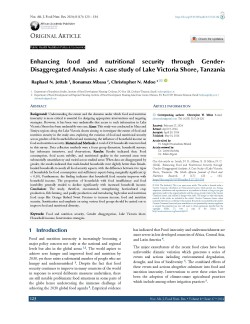Enhancing food and nutritional security through Gender-Disaggregated Analysis: A case study of Lake Victoria Shore, Tanzania
Abstract
Background: Understanding the extent and the domains under which food and nutrition insecurity is more critical is essential for designing appropriate interventions and targeting strategies. However, it has been very undesirable that access to such information in Lake Victoria Shores has been undeniably very rare.
Aims: This study was conducted in Mara and Simiyu regions along the Lake Victoria shores aiming to investigate the extent of food and nutrition security in the study area, exploring the variation of food and nutritional security across genders of the household head and examining the influence of household income on food and nutrition security.
Material and Methods: A total of 450 households were involved in this survey. Data collection methods were a focus group discussion, household surveys, key informant interviews, and observations.
Results: Results indicated that: Food consumption, food access stability, and nutritional quality in the surveyed areas were substantially unsatisfactory and varied across studied areas; When data are disaggregated by gender, the results indicated that male-headed households were slightly better than female-headed households in nearly all food security aspects, with the difference between two types of households for food consumption and sufficiency aspects being marginally significant (p < 0.10). Furthermore, the finding indicates that household food security improves with household income. The proportion of households with food insufficiency and food instability generally tended to decline significantly with increased household income.
Conclusion: The study, therefore, recommends strengthening horticultural crop production, fish farming, and paddy production and introducing high-value and nutritious food crops like Orange fleshed Sweet Potatoes to increase income, food and nutrition security. Sensitization and emphasis on using various food groups should be carried out to improve food and nutritional diversity.
Keywords: Food and nutrition security, Gender disaggregation, Lake Victoria shore, Household income, Intervention strategies.
Full text article
Authors
Copyright (c) 2024 Raphael N. Jettah, Bonamax Mbasa, Christopher N. Mdoe

This work is licensed under a Creative Commons Attribution 4.0 International License.
-
Attribution — You must give appropriate credit, provide a link to the license, and indicate if changes were made. You may do so in any reasonable manner, but not in any way that suggests the licensor endorses you or your use.
-
No additional restrictions — You may not apply legal terms or technological measures that legally restrict others from doing anything the license permits.





